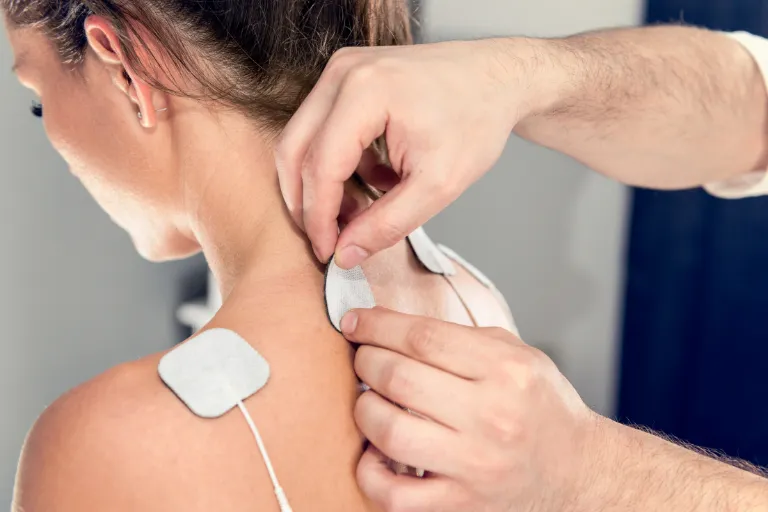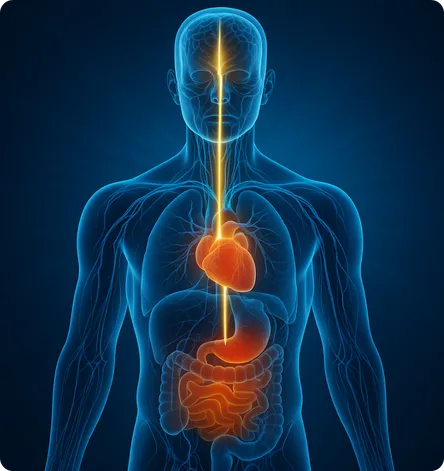TENS was built to target muscles — but your vagus nerve requires a different approach. Discover why auricular stimulation, validated in 50+ clinical studies, is emerging as the safest and most effective way to support nervous system balance.

Why TENS Is Not the Same as Nervous System Stimulation
If you’ve ever experienced back tension or sore muscles, you may have come across TENS devices — machines that deliver electrical pulses through sticky pads on the skin.
TENS (Transcutaneous Electrical Nerve Stimulation) was designed decades ago to temporarily relieve muscle-related discomfort. By sending strong pulses into sensory nerves, it can help distract the body from pain signals.
For that purpose, TENS works well.
But here’s the misunderstanding: TENS is not vagus nerve stimulation.
- It uses higher currents designed for muscle fibers — not the nervous system.
- It’s applied on the back, shoulders, or legs — not on the vagus nerve’s most accessible points.
- It hasn’t been clinically tested for stress balance, recovery, or vagal tone.
Trying to use TENS for the nervous system is like using a hammer to fix a smartphone — the tool doesn’t fit the job.

Meet the Vagus Nerve: Your Body’s Hidden Control Pathway
The vagus nerve is one of the most important — and overlooked — systems in the body.
- It’s the longest cranial nerve, running from the brainstem down through the chest and abdomen.
- It connects the brain with nearly every major organ: heart, lungs, digestive tract, immune tissues.
- It carries signals in both directions:
- Efferent (brain → body): slowing heart rate, calming breathing, activating digestion.
- Afferent (body → brain): sending updates on organ status, gut chemistry, and immune function back to the brain.
This two-way flow makes it the body’s communication superhighway — regulating stress responses, recovery, and internal balance.
When the vagus nerve is active and healthy, your body easily shifts between “fight or flight” and “rest and restore.”
When it’s underactive, your body gets stuck in stress mode — even when you’re safe, fed, and trying to rest.
Why Vagal Tone Matters
Scientists use the term vagal tone to describe how well the vagus nerve functions. Think of it as “nervous system fitness.”
- High vagal tone is linked with higher Heart Rate Variability (HRV) — a sign that your body can adapt to stress and bounce back quickly.
- Low vagal tone is linked with lower HRV — often seen in people struggling with stress, fatigue, sleep issues, and recovery challenges.
Research shows that low HRV is correlated with a range of health problems, including cardiovascular strain, mood imbalances, digestive discomfort, and chronic stress.
HRV: The Nervous System’s Scoreboard
Most wearables today can measure Heart Rate Variability (HRV) — the tiny variation between each heartbeat.
- High HRV means your body is flexible: you can shift smoothly from effort to rest.
- Low HRV means your body is “stuck in gear”: stress systems stay active, even when you’re trying to relax.
That’s why HRV is increasingly called the “stress score” of the body. It reflects your resilience in real time.
And importantly: HRV is not fixed. It can improve — but only if the vagus nerve is re-trained to respond more effectively.
Why the Nervous System Needs More Than TENS
TENS can make muscles twitch. The vagus nerve needs something different: gentle, precise stimulation at the right site.
Here’s why:
- Intensity: TENS devices deliver currents in the tens of milliamps, meant to activate muscle fibers. The vagus nerve responds to microcurrents — thousands of times gentler.
- Placement: TENS pads sit on muscles (shoulders, back, legs). The vagus nerve is most accessible at the ear, where its auricular branch runs close to the skin.
- Outcomes: TENS has trials for short-term pain relief. It does not have validated studies showing HRV improvements, parasympathetic activation, or stress regulation.
- Safety: Using TENS near the neck or chest to “reach” the vagus can be risky, as the nerve runs near sensitive arteries and veins. Misplaced or excessive stimulation here carries the serious risk of disrupting heart rhythm — in extreme cases, this can even stop the heart.
Unlike certified neuromodulation devices, most TENS units are not designed or regulated for vagus nerve use. Their output can spike unpredictably. If intensity ramps too high, you risk irreversible nerve damage, which can lead to long-term complications such as:
- Persistent fatigue
- Chronic digestive dysfunction
- Loss of autonomic balance (similar to what patients experience after surgical vagus nerve damage)
This is why experts warn: never attempt to “hack” the vagus nerve with unregulated TENS devices.
This is why researchers do not recommend repurposing TENS for nervous system work.

The Rise of taVNS: Transcutaneous Vagus Nerve Stimulation
To support vagus nerve activity safely, scientists developed taVNS (transcutaneous auricular vagus nerve stimulation).
Instead of surgical implants (the original VNS method), taVNS uses a small ear clip that delivers low-level, clinically calibrated microcurrents directly to the auricular branch of the vagus nerve.
This approach is:
- Non-invasive: no surgery, no implants
- Precise: targeted to the branch of the vagus nerve most accessible at the ear
- Validated: studied in controlled clinical trials
- Practical: can be used at home while reading, working, or relaxing
Think of it as physical therapy for the vagus nerve. Just as you can train muscles to get stronger, taVNS helps the vagus nerve regain its flexibility.
What Research Shows
Auricular taVNS has been studied in dozens of peer-reviewed trials and reviews:
- Parasympathetic activation: In one controlled study, participants saw up to a 61% increase in parasympathetic activity compared to placebo.
- HRV improvements: Multiple studies report upward trends in Heart Rate Variability with consistent use.
- Symptom exploration: Research has investigated taVNS for its potential influence on sleep quality, mood regulation, digestive comfort, and stress resilience — with participants reporting encouraging results.
- Safety: Across millions of sessions, no serious adverse events have been reported. The most common minor effect is temporary local irritation at the ear.
- Independent validation: A 2024 peer-reviewed review (DOI: 10.5281/zenodo.17042945) concluded that auricular stimulation is the safest and most selective non-invasive pathway for vagus nerve engagement.
This research base is why taVNS is considered a cornerstone of bioelectronic health technology
Why Education Matters Before Choosing a Device
At this point, you may be asking: “If taVNS is validated, why are so many gadgets on the market?”
The answer: not all devices follow science.
Red flags to avoid:
- Unclear stimulation site: If it’s not at the ear, it’s likely not targeting the vagus.
- High-intensity signals: Designed for muscles, not nerves.
- No clinical trials: Marketing claims without peer-reviewed validation.
- No safety data: If safety studies don’t exist, think twice.
When it comes to the nervous system, precision and validation aren’t optional — they’re essential.

Clinical-Grade Auricular tVNS: The Nurosym Device
Non-invasive vagus nerve stimulation (tVNS) has gained increasing attention in research and clinical practice as a way to influence autonomic regulation. Among devices designed for this purpose, Nurosym is one CE-marked option developed for home use. It applies calibrated electrical microstimulation to the auricular branch of the vagus nerve — the specific site most frequently studied in clinical investigations.
Regulatory and Clinical Context
- Certified: Nurosym has received CE-marking in Europe, indicating conformity with safety and performance standards for medical devices.
- Validated: Auricular tVNS has been evaluated in over 50 published trials, ranging from pilot studies to randomized controlled investigations. These studies have examined outcomes including heart rate variability (HRV), inflammatory signaling, fatigue, sleep quality, and stress-related symptoms.
- Trusted: Devices of this type have been incorporated into both research protocols and clinical practice. Reports indicate adoption among clinicians interested in autonomic regulation, though integration into mainstream guidelines is still under development.
- Safety record: Across published literature, auricular tVNS has generally been well tolerated. The most common report is a mild tingling or warmth at the stimulation site. To date, no serious adverse events have been attributed to properly administered auricular tVNS in clinical studies.
Reported Experiences and Observations
Individuals who have trialed auricular tVNS with devices such as Nurosym often describe a sequence of experiences:
- During sessions: Users frequently report a light tingling sensation at the ear accompanied by a subjective sense of calm. This aligns with the proposed mechanism of parasympathetic activation.
- After several weeks of use: Some individuals notice improvements in sleep continuity, reduced perception of afternoon energy dips, and greater stability of daily routines. While such reports are anecdotal, they are consistent with findings from small-scale studies examining HRV and sleep metrics.
- With longer-term use: HRV measurements in some cases show upward trends, suggesting enhanced vagal tone. Individuals often describe improved adaptability to stress, steadier focus, and reduced perception of daily tension. Larger controlled studies are still needed to confirm these long-term effects.
Distinguishing Auricular tVNS from TENS
It is important to clarify how auricular tVNS differs from more commonly available transcutaneous electrical nerve stimulation (TENS) units:
- Purpose-built: TENS devices were originally designed for pain management and deliver stimulation to peripheral muscles and nerves. By contrast, tVNS devices such as Nurosym are calibrated specifically for the vagus nerve.
- Calibrated currents: TENS typically delivers currents in the milliamp range, strong enough to activate muscle fibers and sometimes cause visible contractions. Auricular tVNS employs gentle microcurrents, thousands of times lower in intensity, which are appropriate for modulating neural pathways without muscle activation.
- Validated site: Research has identified the auricular branch of the vagus nerve — accessible at the ear — as the only non-invasive site where stimulation reliably engages vagal pathways. Other approaches (e.g., applying electrodes near the neck) may risk stimulating adjacent structures such as the carotid artery or jugular vein, which carries safety concerns.
- Clinical record: Over 50 peer-reviewed publications have examined auricular tVNS, including systematic reviews. The evidence base for conventional TENS does not include validated effects on HRV or autonomic balance.

Practical Considerations for Daily Use
Nurosym and similar devices are designed for ease of integration into daily routines.
- Electrode placement: The electrode clips onto the tragus of the ear. Unlike TENS pads, no conductive gel is required, reducing mess and making use more convenient on the go.
- Comfort adjustment: Intensity is adjustable, and most individuals describe the sensation as a mild tingling that can be titrated for comfort.
- Activity during sessions: Because stimulation is localized and non-disruptive, individuals can typically read, plan, or relax while using the device.
- Typical protocol: Many protocols involve 30 minutes of daily use, with some individuals choosing an additional evening session to support relaxation and recovery.
Potential Outcomes
While responses vary, the following outcomes have been described in both user reports and clinical research contexts:
- Morning readiness: Some individuals report waking with greater ease and less reliance on stimulants such as caffeine.
- Stress response: Daily stressors may feel more manageable, consistent with the hypothesis of enhanced vagal tone.
- Energy stability: Reduced perception of mid-day “crashes,” with steadier focus throughout the day.
- Evening recovery: A more natural sense of winding down at night, sometimes accompanied by improved sleep quality.
- Objective confirmation: HRV tracking devices often show upward trends during consistent use, reflecting improved autonomic adaptability.
FAQ
Can I just use my TENS unit for vagus stimulation?
No. TENS is not designed for this purpose. It uses higher currents, targets muscles, and lacks validation for nervous system outcomes.
Is Nurosym safe?
Yes. Published research shows no serious adverse events in studies to date. Minor effects like local ear irritation are rare and temporary.
Will I feel the results quickly?
Some users feel calmer during sessions. Measurable changes in HRV and resilience build with consistent use.
Do I need to track HRV?
It’s optional — but many enjoy seeing data confirm what they feel.
What if it doesn’t suit me?
Every Nurosym comes with a 30-day money-back guarantee.
Your Next Step
TENS was built for muscles. Your nervous system deserves precision.
With Nurosym, you can access clinically validated auricular vagus nerve stimulation at home — safe, simple, and measurable.
Don’t repurpose. Don’t guess. Choose the method designed for the job.
Disclaimer: This page is for educational purposes only. It does not provide medical advice. Always consult a qualified healthcare professional before starting new therapies.
REFERENCES:
- Butt, M. F., Albusoda, A., Farmer, A. D., & Aziz, Q. (2020). The anatomical basis for transcutaneous auricular vagus nerve stimulation. Journal of Anatomy, 236(4), 588–611. https://doi.org/10.1111/joa.13122
- Peuker, E. T., & Filler, T. J. (2002). The nerve supply of the human auricle. Clinical Anatomy, 15(1), 35–37. https://doi.org/10.1002/ca.1089
- Kreuzer, P. M., Landgrebe, M., Husser, O., Resch, M., Schecklmann, M., Geisreiter, F., … Langguth, B. (2012). Transcutaneous vagus nerve stimulation: Retrospective assessment of cardiac safety in a pilot study. Frontiers in Psychiatry, 3, 70. https://doi.org/10.3389/fpsyt.2012.00070
- Clancy, J. A., Mary, D. A., Witte, K. K., Greenwood, J. P., Deuchars, S. A., & Deuchars, J. (2014). Non-invasive vagus nerve stimulation in healthy humans reduces sympathetic nerve activity. Brain Stimulation, 7(6), 871–877. https://doi.org/10.1016/j.brs.2014.07.031
- Kim, A. Y., Marduy, A., de Melo, P. S., Gianlorenco, A. C., Kim, C. K., Choi, H., Song, J.-J., & Fregni, F. (2022). Safety of transcutaneous auricular vagus nerve stimulation (taVNS): A systematic review and meta-analysis. Scientific Reports, 12(1), 22055. https://doi.org/10.1038/s41598-022-25864-1
- Food and Drug Administration. (2019). General Wellness: Policy for Low Risk Devices (Guidance for Industry and FDA Staff). Retrieved from https://www.fda.gov/media/90652/download
Share via:


